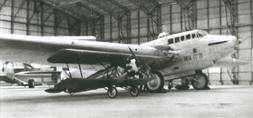Breda Ba.19
| Ba.19 | |
|---|---|
 | |
| Role | Military aerobatic trainer |
| Manufacturer | Breda |
| Designer | Cesare Pallavicino |
| First flight | 1928 |
| Introduction | 1931 |
| Primary user | Regia Aeronautica |
| Number built | 42 |
|
| |

The Breda Ba.19 was an Italian single-seat aerobatic biplane aircraft developed as an air force trainer in 1928.
Design and development
The Breda Ba.19 was a single-bay, unequal-span, unstaggered biplane of conventional configuration which seated its pilot in an open cockpit. A few Ba.19s were produced as two-seaters with a second open cockpit in tandem with the first.
Operational history
The Ba.19s were used throughout the 1930s for display flights by the Squadriglia di Alta Acrobazia Aerea, performing formation aerobatics.
Operators
- Regia Aeronautica
- Squadriglia di Alta Acrobazia Aerea
Specifications
General characteristics
- Crew: 1, pilot
- Length: 6.60 m (21 ft 8 in)
- Wingspan: 9.00 m (29 ft 6 in)
- Height: 2.20 m (7 ft 3 in)
- Wing area: 25.0 m2 (269 ft2)
- Empty weight: 735 kg (1,620 lb)
- Powerplant: 1 × Alfa Romeo licence-built Armstrong Siddeley Lynx radial, 149 kW (200 hp)
Performance
- Maximum speed: 210 km/h (131 mph)
- Range: 840 km (522 miles)
- Service ceiling: 7,000[1] m (22,960 ft)
See also
References
- Notes
- ↑ Angelucci 1983, p. 124.
- Bibliography
- Angelucci, Enzo. The Rand McNally Encyclopedia of Military Aircraft, 1914–1980. San Diego, California: The Military Press, 1983. ISBN 0-517-41021-4.
- Taylor, Michael J. H. Jane's Encyclopedia of Aviation. London: Studio Editions, 1989, p. 195.
External links
| Wikimedia Commons has media related to Breda Ba.19. |
This article is issued from Wikipedia - version of the 11/12/2016. The text is available under the Creative Commons Attribution/Share Alike but additional terms may apply for the media files.